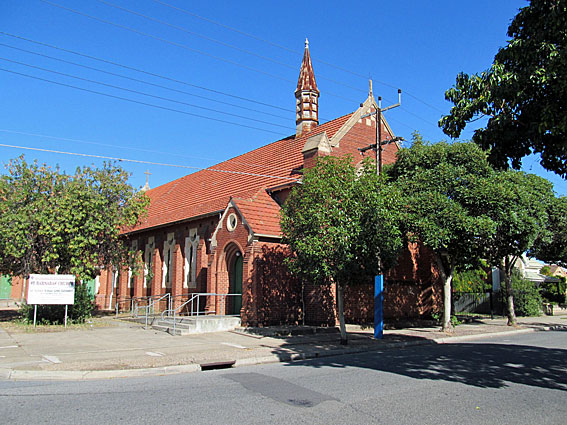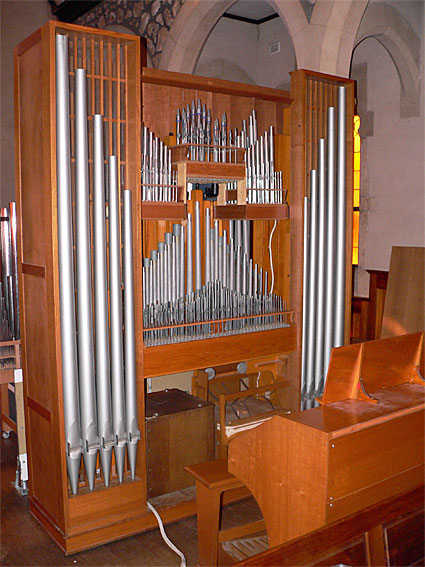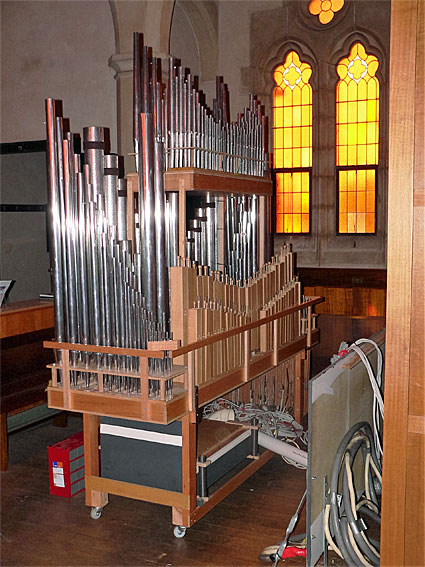
St Barnabas' Church, Croydon
[Wikimedia Commons (2015)]

St Barnabas' Church, Croydon
[Wikimedia Commons (2015)]
Historical and Technical Documentation by Bruce Naylor, Ian Wardle and others
© OHTA 1996, 2019 (last updated September 2019)
A worshipping community has met on the site of St Barnabas since 1905. The foundation stone of the present church, designed by architect Mr Dean Berry, was laid in May 1929, and the building was opened in September that year.1
This organ in this location between c.2010 and 2015 had grown from one built in 1966 by J.E. Dodd & Sons, Gunstar Organ Works of Adelaide, as a practice organ for the Music Department, University of Adelaide. It was originally a three-rank extension organ,2 the pipework deriving from A. Palmer & Son of London.
The instrument was purchased in 1989 by The Revd Bruce Naylor (1927-2017). Naylor had been ordained Priest in the Anglican Diocese of Adelaide in 1979, and was Rector of St Agnes' Anglican Church, Grange, 1985-1993. Upon retiring from that position, he became Vicar Choral and one of the assistant organists at St Peter's Cathedral, Adelaide,3 residing successively at Semaphor and Rosewater.
The organ was installed initially in the hall at Grange, and was later moved to Bruce Naylor's residences at Semaphor (c.1992) and Rosewater (c.2005). It was installed by Ian Wardle in St Barnabas' Church around 2010.
  The enlarged Dodd/Jacob extension organ [Photographs by Ian Wardle (c.2015)] |
The instrument was enlarged on several occasions, using pipework supplied by Aug. Laukhuff of Germany. Two (2) ranks were added by Leith Jacob in 1993 and one (1) rank by George Stevens in 1994. The third manual was added in 2004 by Leith Jacob, who added a further eleven (11) ranks in 2006.4 It eventually comprised 41 stops derived from 17 ranks, including some ranks of short compass.5
The final specification was as follows:-
| Great (Manual II) Bourdon 16 Gemshorn 8 Rohr Flute 8 Principal 4 Quintaton 4 Twelfth 2-2/3 Piccolo 2 Fifteenth 2 Tierce 1-3/5 Mixture II Rankett 8 Positive (Manual I) Gedackt 8 Flute 4 Nazard 2-2/3 Octave 2 Larigot 1-1/3 Tierce 1-3/5 Septieme 1-1/7 Zimbel I Rankett 16 Clarinet 8 Echo (Manual III) Bourdon 16 Gedackt 8 Gamba 8 Octave 4 Koppel 4 Flach Flote 2 Larigot 1-1/3 22nd 1 Cor Angles II Pedal Resultant 32 Bourdon 16 Gemshorn 8 Gedackt 8 Principal 4 Quintaton 4 Flach Flote 2 Mixture III Rankett 16 Clarinet 8 Clarinet 4 |
16 8 8 4 4 2-2/3 2 2 1-3/5 II 8 8 4 2-2/3 2 1-1/3 1-3/5 1-1/7 I 16 8 16 8 8 4 4 2 1-1/3 1 II 32 16 8 8 4 4 2 III 16 8 4 |
Compass: 61/32
Direct electric action
No couplers
No pistons
Pipework entirely unenclosed.6
The organ has been in storage since 2015 at the workshop of Ian Wardle, Paracombe.
____________________________________________________
1 The Advertiser (11 May 1929), p. 11; News (28 September 1929), p. 3.
2 Specification noted 1968; information supplied by L. Porter, 1969.
3 Personal communication from Bruce Naylor to Geoffrey Cox, September 2006; Naylor obituary in OHTA News, vol. 42, no. 3 (July 2017), p. 4.
4 Information supplied by Bruce Naylor, 1996 and 2005.
5 Observations by Ian Wardle, 2019.
6 Specification noted by Ian Wardle, 2019.